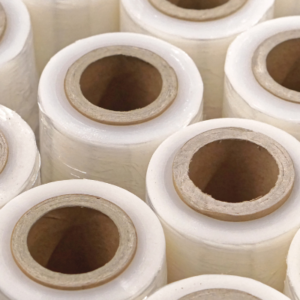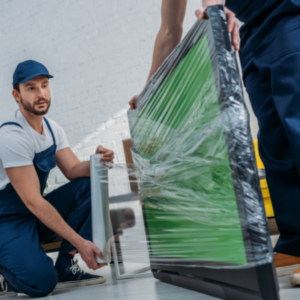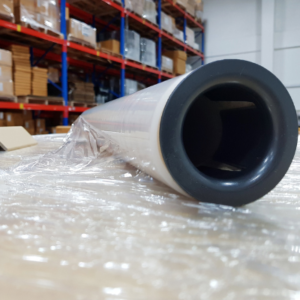The Complete Guide to Stretch Wrap
Stretch wrapping pallets is an effective and productive method for ensuring the stability and security of cartons during transit or storage. Stretch wrap is a thin, stretchable plastic film that is made from polyethene and is recyclable for businesses. The film is wrapped around the pallet, applying tension and enabling the film to prolong its length, creating a force that allows parcels to be firmly held in one position. The flexible material stretches to keep pallets compact and waterproof. This helps avoid movement during transport and as a result, minimises product damage or loss. Incorporating stretch wrap into the packing process can help save you money on replacing stock, avoids dust or moisture contaminating items, and discourages pallet tampering or pilferage. Added positives of using stretch film include lowering stress and anguish from warehouse managers due to them no longer having to worry about the status or condition of goods during delivery. There are different choices on the packaging market for pallet wrap. Using the correct type of film can improve annual savings and pallet performance. In this blog, we will be explaining the benefits of stretch wrap and which types you should be using to improve your packaging operations.

The Advantages of Using Stretch Wrap
Stretch wrap is used to lower the risk of problems occurring during transit such as water or general product damage, mishandling, loss, and theft. The material is available to buy from most packaging suppliers in a variety of lengths, widths, thicknesses, and colours to protect a wide range of product types. There are many reasons why wrapping pallets brings benefits to businesses, some of which include:
– It lowers the chance of boxes being interfered with before reaching the consumer.
– Products are protected from moisture, dust and dirt seeping through and causing damage.
– Injuries are prevented due to cartons being securely wrapped in place and so will not fall on warehouse operators or anyone handling them during their journey.
– Stack height is increased when a stretch wrap is used in conjunction with edge protectors, allowing cube space to be maximised due to a higher pallet load being formed.
– Your parcels are kept clean, dry, and in great condition, ensuring that your customers won’t be disappointed with the product they receive.
The Different Types of Stretch Wrap and Applications
The are several variations of stretch film and they are all suitable for addressing different pallet loads based on product size, performance requirements such as travel duration, the price of goods, and budget for the wrap itself.
- Pre-stretch Film: This version of pallet wrap holds a huge hint in its name. The material is pre-stretched during the manufacturing stage to increase its strength, improve load stability, reduce waste, and lower packaging costs. It can be used both manually and with a machine to speed up the wrapping process.
- Cast Stretch Wrap: This formulation provides a smooth surface with impressive optics, gloss, strength, and cling without involving any unnecessary additives or chemicals. Cast stretch wrap is a strong film that sticks to itself to prevent products on pallets from moving. This type of pallet film is popular in the food industry due to its adaptability.
- Blown Stretch Film: Created using a process known as blown extrusion, this type of wrap is most suitable for heavy or bulky pallet loads. This is because it is a stronger material that provides excellent puncture and tear resistance and is a more indestructible form of stretch wrap. The only negative of blown stretch film is that it can make a significant level of noise when its wheels of it are being unwound.
- Black Stretch Wrap: Coloured stretch wrap – particularly black – is incredibly useful when expensive products are being transported or stored. The tainted material helps disguise the cartons underneath lowering the chance of stock theft. This ensures your items are safe, not only by minimising movement or product contamination but also by lowering the risk of pilferage.

Stretch wrap can be applied to pallets in three ways: manually, semi-automatically, and automatically. Managing loads can be repetitive, time-consuming, and dangerous. That is why it is useful to implement the application technique best suited for your warehouse and operators depending on your average employee age, the busyness of the warehouse, and the weight of the loads that are being wrapped.
- Machine Stretch Film: This branch of wrap is designed to be used with a machine and is a practice that can be automatic or semi-automatic. Benefits of using machine pallet wrap can include more efficient and consistent wrapping, reduced packaging material costs, safer application and more secure loads. This is why it is mostly used for heavy, bulky and irregular pallet loads.
- Hand Applied Stretch Wrap: Hand-held film is used most often for manual packing operations. Because of this, hand film rolls are lighter and smaller compared to machine stretch film to improve the productivity and ease of the application process. Therefore, this variant of stretch wrap is most used by companies that wrap small volumes of products. Hand-applied stretch wraps include standard cast film, standard blown film, pre-stretched film, coloured film and dispensers.
How to Know Which Film is Best for your Warehouse
The most suitable form of pallet stretch wrap depends on the type of products you are attempting to wrap and ship. When choosing which film to buy, you should consider the following factors:
Performance: One thing that is extremely important to understand when deciding on a stretch wrap is its yield strength. Yield strength refers to the amount of stress a stretch film can withstand without deforming the plastic used around the pallet. Before reaching its final yield point the stretch film will elastically deform but return to its original shape once the stress is removed. Knowing when this point is and how well the wrap performs under pressure can help you decide on whether it is strong enough for heavy or bulky loads if your warehouse deals with them regularly.
Overlapping: Overlapping is a wrapping technique used to ensure the covering and protection of the top of the pallet using polythene sheets. This safeguards the products and provides a downward force on the pallet to improve its stability. When overlapping hand-applied films, it is recommended users allow up to 50% overlap. If using machine-applied films, a 50mm overlap should be allowed, regardless of the film width. Overlap is something that should be considered when buying stretch wrap as you may need a larger width or length depending on if you require your staff to enforce this wrapping method.
Banding: This term refers to the process of applying multiple layers of stretch film over a pallet to reinforce the load and have optimal protection of the goods. When buying a certain length of a stretch wrap roll, this should be thought about as you might want to buy a longer roll based on this wrapping method.
Neckdown: This is something that happens when a film loses its dispensing roll width and narrows down while being stretched around the load. Neckdown reduces the coverage provided by the stretch wrap, meaning more rotations of the material are needed and as a result, more wrap would need to be bought beforehand.
Products: One of the more obvious considerations is the type of products being loaded onto a pallet. Before purchasing stretch wrap you should look at the pattern of your carton load and its weight, as you might need a more durable form such as blown stretch wrap to ensure the safety of your stock.
Time, Use and Cost: Depending on the size and popularity of your company, you might want a larger or stronger stretch wrap. Hand wrapping is best suited for smaller wrapping operations. You should introduce machine wrapping for bigger operations where you want to save time, resources, and packaging materials.

Overall, there is more to stretch wrap than what is first thought. Available in a variety of lengths, thicknesses, yield strengths, and colours, it can be a hard decision to know which is best for your pallet loads. If you need more help understanding which form of pallet wrap you should buy to give your stock the optimal level of protection and stability during transit or storage, call Davpack at 01332 821200 or email a friendly member of our customer services team at cs@davpack.co.uk.
Sarah Hickson
Latest posts by Sarah Hickson (see all)
- What is Sugarcane Fiber and Why is it the Most Sustainable Material on the Market? - 1st September 2022
- Packaging that is More than Just a Cardboard Box – Easy Branding Boxes - 27th July 2022
- How to Protect Temperature-Sensitive Goods During Transit - 14th July 2022
